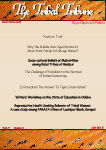Nature Talk
Socio-economic caste census and scheduled tribes
The Socio-Economic Caste Census (SECC 2011) released on the 3rd July, 2015 by Arun Jaitley and Chaudhary Birender Singh, respectively the ministers of Finance and Rural Development, Government of India, has been for quite sometimes conspicuous by its presence in the newspaper headlines. This census, which commenced on the 29th June 2011, in Hazemora Block in West Tripura under the aegis of the previous government had a promise built into it that it would be put in the public domain as soon as it would be completed. The present government has commendably honored this promise endorsing the claim of Jairam Ramesh, the Rural Development Minister in the previous government, that for the first time since independence such a comprehensive exercise is being carried out. It is another matter that the findings of the census, which took four years to be completed, though the date targeted was May 31, 2012, are a sad commentary on the sixty-five year long governance of the country, particularly the rural India. The objectives enumerated for SECC 2011 were: (i) ‘to enable households to be ranked based on their socio-economic status such that State Governments can then prepare a list of families living below the poverty line’, (ii) ‘to make available authentic information that will enable caste-wise population enumeration of the country’ and (iii) ‘to make available authentic information regarding the socio-economic condition and education status of various castes and sections of the population’. Notwithstanding these objectives and the mandate to put the findings of the census in the public domain, it had been decided from the beginning of the census, as stated in Socio-Economic and Caste Census 2011 in Rural India, November 2011, Ministry of Rural Development, Government of India, not to release caste related data to the public. It is surprising that the party, which had taken such a decision while in government, now being in opposition, reportedly demands its release albeit with some caution. Naturally the present government not releasing caste related data has caused consternation in political circles, particularly among other backward community (OBC) leaders who have become quite vociferous in their demand for its release. While caste related data are withheld from public view, making it difficult to know the relative socio-economic status of the castes, the data related to scheduled castes and scheduled tribes have been duly posted in public domain.
The uniqueness of SECC 2011 lies in identifying households based on indicators clubbed into three criteria, viz., ‘automatic exclusion’ ‘automatic inclusion’ and ‘deprivation’. It is claimed that ‘Automatic Exclusion’ criteria reduces the possibility of trespass of ineligible households into the BPL list’, while ‘Automatic Inclusion’ criteria and deprivation score under ‘deprivation’ criteria increase the possibility of the most eligible people being included in the BPL list.
This survey which was carried over 179.1 million households in rural India across 640 districts, includes 33.06 million Scheduled Caste (SC) households, 19.65 million Scheduled Tribe (ST) households and 22.98 million women-headed households. It is significant to find that of such different categories of the households, the proportion of households ‘automatically excluded’ is the lowest among the ST households. It is 21.33% as against 27.09% among SC households, 35.39% among women headed households and 39% among all households. In respect of ‘automatic inclusion’, the proportion of households ‘automatically included’ is the highest, 4.19% among ST households as against 0.6% among SC households, 1.72% among women-headed households and 0.92% among all households. Further with regard to ‘deprivation’, the proportion within ST households is the highest (74.29%) followed by 71.93% among SC households, 56.2% among women-headed households, whereas it is 48.5% among all households. These figures suggest that the ST communities deserve the highest priority in the programs that the government contemplates for the uplift of the people in rural India. The other findings of this survey reveal that among scheduled tribe households, compared to other categories of the households, (i) the proportion of landless households is the lowest (50%), (ii) the proportion of households having cultivation as main source of income is the highest (37.922%), (iii) the proportion of households depending on the manual casual labour as their main source of income almost the lowest (51.33% as against 51% among all households), (iv) the proportion of households earning less than Rs.5000/ per month is the highest (87%), (v) the proportion of salaried households is the lowest (6.44%) and (vi) the proportion of households in possession of assets (2/3/4 wheelers/fishing boat/refrigerator) is the lowest (13.22%).
Certainly, an innovative strategy towards tribal development has become imperative. These figures do imply that there is no small a proportion of tribal households who own land but do not depend on it for their living. Such lands, not surprisingly, have attracted the observation that it “might be useful to buy the lands for building factories and industries if the Land Bill is passed in parliament. That will create jobs, which will raise incomes of households, which are hardly earning anything from sitting on unproductive land”.
Alternatively, can such lands, instead of being bought for setting up factories and buildings be bought by the government for distribution among the landless tribal households who would take to cultivate it?
Needless to say, the SECC 2011 is an extremely important eye-opening document. One only wishes this document stirs our policy makers and bureaucrats to appreciate the realities of rural India, and the plight of tribal households in particular and formulate a holistic strategy for their development. It would be a tragedy if this document meets the fate of those documents, which have been shelved to gather dust. (BKN)



